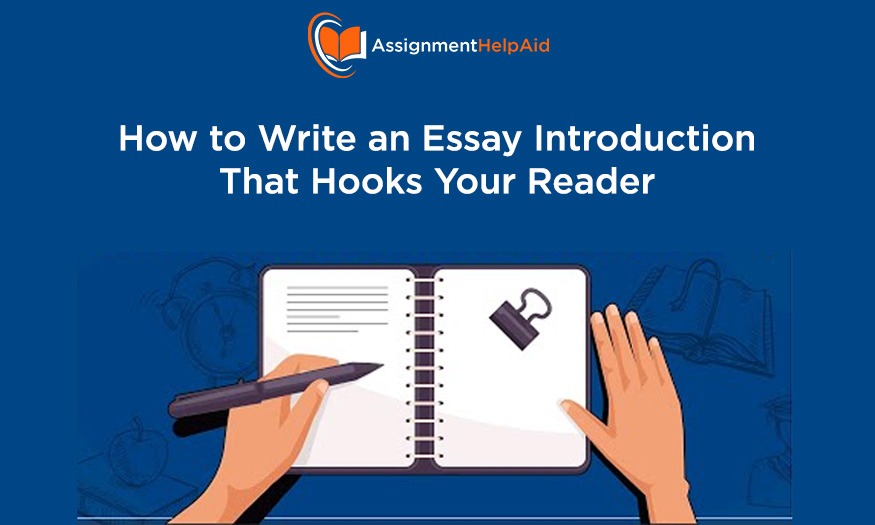
How to Write an Essay Introduction That Hooks Your Reader
You’ve likely brainstormed some interesting ideas for your essay, hoping to capture your reader’s attention just by the attractive essay introduction. At times, you might ponder how to grip your readers right from the outset, ensuring they stay engaged throughout your entire essay. It’s crucial to understand that crafting a compelling introduction paragraph is key to achieving this goal. Your introduction serves as the initial opportunity to make a favorable impression on your readers.
How to Write an Essay Introduction
By starting with a strong introduction, you set the tone for the rest of your essay and establish credibility as a writer. It’s where you lay out the main points and provide a preview of what’s to come. A well-crafted introduction not only grabs attention but also creates anticipation for what lies ahead in your writing.
Moreover, when you put effort into writing concise and engaging essays for your class assignments, you’re likely to earn appreciation from your professors. Additionally, your peers may admire your writing skills, possibly leading to a positive reputation among them. So, investing time and attention into perfecting your essay introductions can pay off in terms of academic recognition and social standing.
What is Essay Introduction
The introduction of your essay is a reflection of your personality and writing style. It sets the stage for your readers, giving them an idea of what to expect from your writing. Essentially, your introduction serves as a bridge that connects your readers to the topic you are about to discuss. Crafting a compelling introduction is the first crucial step in the essay-writing process and can significantly influence how your readers perceive the rest of your essay.
Crafting a Good Introduction
To write an effective introduction for your essay, you need to follow a structured approach. Here’s a detailed guide:
- Choose Your Topic: Start by selecting a clear and focused topic for your essay. Your topic should be specific enough to cover in detail but broad enough to allow for comprehensive discussion.
- Focus on a Specific Area: Once you have your topic, narrow it down to a particular aspect that you want to explore. This will help you stay focused and make your research more manageable.
- Decide on Your Thesis Statement: Your thesis statement is the central idea of your essay. It should succinctly express the main point or argument you will be making. Your entire essay will revolve around this statement, so make sure it is clear and specific.
- Include Background Information: Provide some context or background information about your topic. This helps your readers understand the significance of your thesis and sets the stage for your argument.
A Three-Step Process for a Strong Introduction
To make your introduction even more impactful, you can follow a comprehensive three-step process:
- State Your Position: Begin your essay by clearly stating whether you are for or against the main argument. This provides your readers with a clear idea of the stance you will be taking throughout your essay. For example, if you are writing about climate change, you might start by stating your position on the importance of immediate action to mitigate its effects.
- Define Key Terms: It’s important to define any key terms or concepts that are central to your essay. Providing clear definitions helps eliminate any confusion or ambiguity for your readers. For instance, if your essay involves technical terms or jargon, make sure to explain these terms in simple language. This ensures that all your readers, regardless of their prior knowledge, can follow your argument.
- Outline Your Argument: In this part of the introduction, provide a brief overview or roadmap of your main points. Start with a mini-argument that summarizes your overall stance. Then, hint at the main points you will be discussing in the body of your essay. This approach not only engages your readers but also helps them understand the structure and flow of your argument. For example, if you are writing about the benefits of renewable energy, you might start with a brief statement about its importance and then outline the specific benefits you will discuss, such as environmental impact, cost savings, and sustainability.
Additional Tips for a Compelling Introduction
- Capture Interest: Use a hook at the beginning of your introduction to grab your reader’s attention. This could be an interesting fact, a quote, a question, or a brief anecdote related to your topic.
- Be Clear and Concise: While it’s important to provide enough information to set the stage, avoid overwhelming your readers with too much detail in the introduction. Keep it focused and to the point.
- Set the Tone: Your introduction sets the tone for your entire essay. Make sure it matches the style and tone of the rest of your writing, whether it’s formal, informal, persuasive, or analytical.
By following these steps and tips, you can write an introduction that not only captures your readers’ interest but also provides a clear and engaging starting point for your essay. A well-crafted introduction paves the way for a strong and compelling essay, helping you to effectively communicate your ideas and arguments.
Tips for Writing Effective Essay Introduction
Struggling to start your essay with an engaging introduction? You’re not alone. Many experienced writers find it challenging to craft a compelling opening. The key is to know various techniques that can make your introduction interesting. Your approach will depend on the type of essay and the topic you’re writing about.
First, identify your target audience. Understand who will be reading your essay, considering their age group and location. Also, be clear about the purpose of your essay and the direction it will take.
To write a captivating introduction, start with commonly accepted beliefs. Then, introduce ideas that some people might disagree with or find doubtful. This will help you develop your thesis statement for an argumentative essay. Using statistics related to your topic can also help establish your credibility from the start.
Another effective method is to begin with a memorable incident. The rest of your essay can then expand on this story, making readers emotionally invested. You can also ask questions about the incident to engage your audience. This approach works well for narrative essays that focus on human interest topics.
Common Mistakes to Avoid in Essay Introductions
Knowing your common weaknesses can help you avoid mistakes in your essay introductions that might cause readers to lose interest.
Not Addressing the Question
Start your introduction with background information on the subject. Then, clearly state your main argument in the next sentence. Finally, summarize your overall stance on the topic in the last part of your introduction.
Straying from the Main Topic
Stay focused on the topic and avoid straying off course. Your essay should provide accurate information with clear reasoning. Ensure your thesis statement is consistent throughout your essay, from the introduction to the conclusion.
Using Informal Language
Write in a formal tone and avoid casual language. Use precise and strong words, and limit rhetorical questions that might distract readers. Academic papers should not use second-person narratives.
Overusing Colloquial Terms
Avoid slang and casual expressions in your research paper. These can make your writing seem unprofessional and may suggest that you are telling readers what they already know.
Lack of Proper References
Always provide proper references when you use ideas from other sources. Failing to credit other authors can be seen as plagiarism.
Examples of Effective Essay Introductions
Struggling to come up with a good introduction for your essay? Here are some examples that can help you create an engaging start and impress your readers.
Grab Your Reader’s Attention Immediately
Start with a thought-provoking question:
“Is it necessary and reasonable to charge money for works of art in a museum compared to street art?”
Develop Interest with Interesting Quotes
Use a quote from a well-known person:
“A famous American thinker once said, ‘Every artist was first an amateur,’ but in reality, not every artist has a professional approach.”
Begin Your Introduction with Your Topic Sentence
Start with some background information:
“For many centuries, Western art was defined by religious practices like the church. In other periods, art was seen as an expression of the elite class. Contemporary graffiti shows that art cannot be judged or limited.”
Design Your Thesis Statement with Particular Details
Include relevant background information in your thesis statement:
“Beauty is in the eye of the beholder, whether it’s on a canvas in a museum or the ceiling of the Sistine Chapel.”
Explain Your Thesis Statement with a Clear Argument
Make your thesis statement clear and present your main points:
“Murals, graffiti, and other forms of street art have historically been considered part of the fine arts, showing that true art can be found in unexpected places.”
Conclusion
Writing an engaging opening paragraph to grab your readers’ attention is challenging. However, once your introduction is appealing, your readers will likely keep reading. With the tips and examples provided, you can create a great introduction for your assignments.
At AssignmentHelpaid, we offer plagiarism-free solutions for your assignments from our qualified experts. Our services include editing, rewriting, and writing your assignments from scratch. AssignmentHelpaid provides dissertation help, homework help, coursework help, and support with academic essays. Feel free to contact us—we’re always here to assist you!

